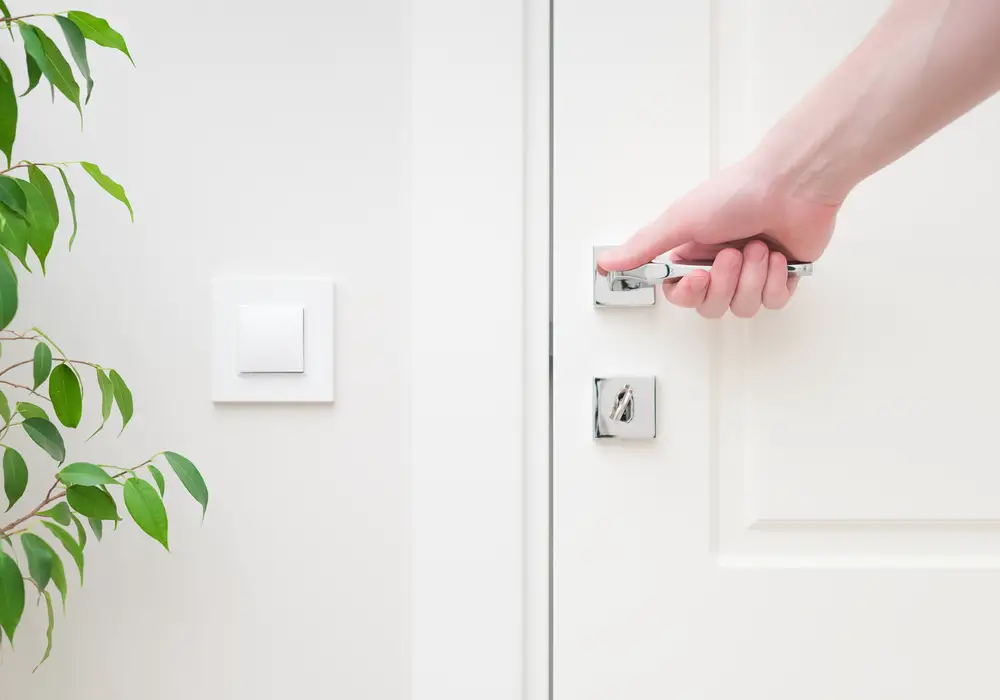Can a light switch be behind a door? This is a question that many homeowners ask themselves when planning the layout of their home or considering a renovation.
While it may seem like a convenient location for a light switch, there are some potential safety and accessibility concerns to consider.
In this article, we will explore the pros and cons of placing a light switch behind a door and provide tips on how to ensure that it is safe and accessible for all.
Key Takeaways
- The ideal distance of a light switch from a door can vary based on local building codes, room layout, and personal preferences.
- Accessibility is a crucial consideration when it comes to light switches, and the location of your light switch can affect your ability to turn your lights on and off easily and safely.
- Specific room considerations can also play a role in determining the placement of your light switch.
Accessibility and Light Switches
Light switches are an essential part of any home or building. They provide easy access to lighting and help ensure safety. However, the location of light switches can greatly affect their accessibility. In this section, we will explore the general accessibility of light switches, as well as their accessibility for wheelchairs and kids.
General Accessibility
According to the Americans with Disabilities Act (ADA), light switches must be located in accessible spaces and along accessible routes.
Operable parts, including light switches, must be within reach of people with disabilities.
This means that they should be no higher than 48 inches above the floor and no lower than 15 inches above the floor. Light switches should also be easy to operate, requiring no more than 5 pounds of force.
Accessibility for Wheelchairs
For people in wheelchairs, light switches should be located along an accessible path of travel.
This means that they should be within reach of someone in a wheelchair. Light switches should not be located in alcoves or other areas that are not accessible to someone in a wheelchair.
Additionally, light switches should not be located behind doors or in other areas that require someone in a wheelchair to reach across a hazardous area.
Accessibility for Kids
For kids, light switches should be located at a height that is easy for them to reach. This means that they should be no higher than 36 inches above the floor.
Additionally, light switches should be easy to operate, requiring no more than a gentle push or pull. In homes with small children, it may be helpful to install childproof covers over light switches to prevent accidental switching.
Specific Room Considerations
When it comes to light switch placement, there are specific considerations to keep in mind for each room in your home. Here are some things to keep in mind when deciding where to place your light switches.
Bathroom Considerations
In a bathroom, it’s important to consider the location of your light switch in relation to water sources.
According to the National Electric Code (NEC), light switches should be placed at least 60 inches away from any standing water source, such as a bathtub or shower. This is to prevent any electrical shock hazards.
Another thing to consider in a bathroom is the door swing. If your bathroom door swings inward, you’ll want to make sure that your light switch is placed on the opposite side of the door from the hinges. This will prevent the door from hitting the light switch when it’s opened.
Entrance Considerations
In an entrance or hallway, you’ll want to make sure that your light switch is easily accessible as soon as you enter the room. This means placing it within arm’s reach of the door.
According to the Americans with Disabilities Act (ADA), light switches should be placed between 15 and 48 inches from the floor. If there are any obstructions in front of the switch, the maximum height may be lower.
When it comes to door swing in an entrance, you’ll want to make sure that the door doesn’t hit the light switch when it’s opened. If the door swings inward, you’ll want to place the light switch on the opposite side of the door from the hinges.
Outlets
It’s important to note that light switches and outlets cannot be placed in the same box. This is because light switches and outlets require different wiring configurations. If you need both a light switch and an outlet in the same location, you’ll need to use a double-gang box.
Overall, when deciding where to place your light switches, it’s important to consider the specific needs of each room in your home. By keeping these considerations in mind, you can ensure that your light switches are placed in the most convenient and safe locations possible.
Conclusion
In conclusion, the location of a light switch is an important factor to consider when installing electrical wiring in your home. It is crucial to follow the National Electrical Code (NEC) guidelines to ensure the safety of your family, employees, and property.
It is important to consult a licensed electrician to ensure that your electrical wiring is installed correctly and meets all safety requirements. They can advise you on the best location for your light switch and ensure that it is installed safely.
Remember, safety should always be your top priority when dealing with electrical wiring. By following the NEC guidelines and consulting a licensed electrician, you can ensure that your home or office is safe and secure.

